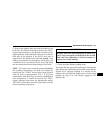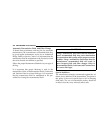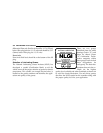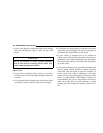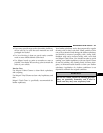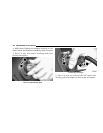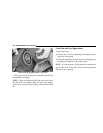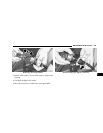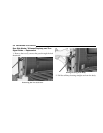
contain “Mini”fuses and plug-in “ISO” relays. A label
inside the latching cover of the Power Distribution Cen-
ters identifies each component for ease of replacement, if
necessary. These fuses and relays can be obtained from
your dealer.
CAUTION!
When replacing a blown fuse, it is important to use
only a fuse having the correct amperage rating. The
use of a fuse with a rating other than indicated may
result in a dangerous electrical system overload. If a
properly rated fuse continues to blow, it suggests a
problem in the circuit that must be corrected.
NOTE: If you are leaving your vehicle dormant for
longer than 21 days you may want to take steps to protect
your battery. You may do this by disconnecting the
battery or by disconnecting the two ignition-off draw
(I.O.D.) fuses located in the Auxiliary Power Distribution
Center (PDC) located in the engine compartment. The
I.O.D. cavities include a snap-in retainer that allows the
fuse to be disconnected, without removing it from the
fuse block. Pressing the I.O.D. fuse back into the cavity
reconnects it.
VEHICLE STORAGE
If you are storing your vehicle for more than 21 days, we
recommend that you take the following steps to mini-
mize the drain on your vehicle’s battery:
•
Disconnect the Ignition-Off Draw fuse (I.O.D.) fuse
located in the Power Distribution Center (PDC). The
I.O.D. cavity includes a snap-in retainer that allows the
fuse to be disconnected, without removing it from the
fuse block.
•
The transfer case should be placed in the 4HI mode
and kept in this position to minimize the battery drain.
•
As an alternative to the above steps you may discon-
nect the negative cable from the battery.
MAINTAINING YOUR VEHICLE 329
7



